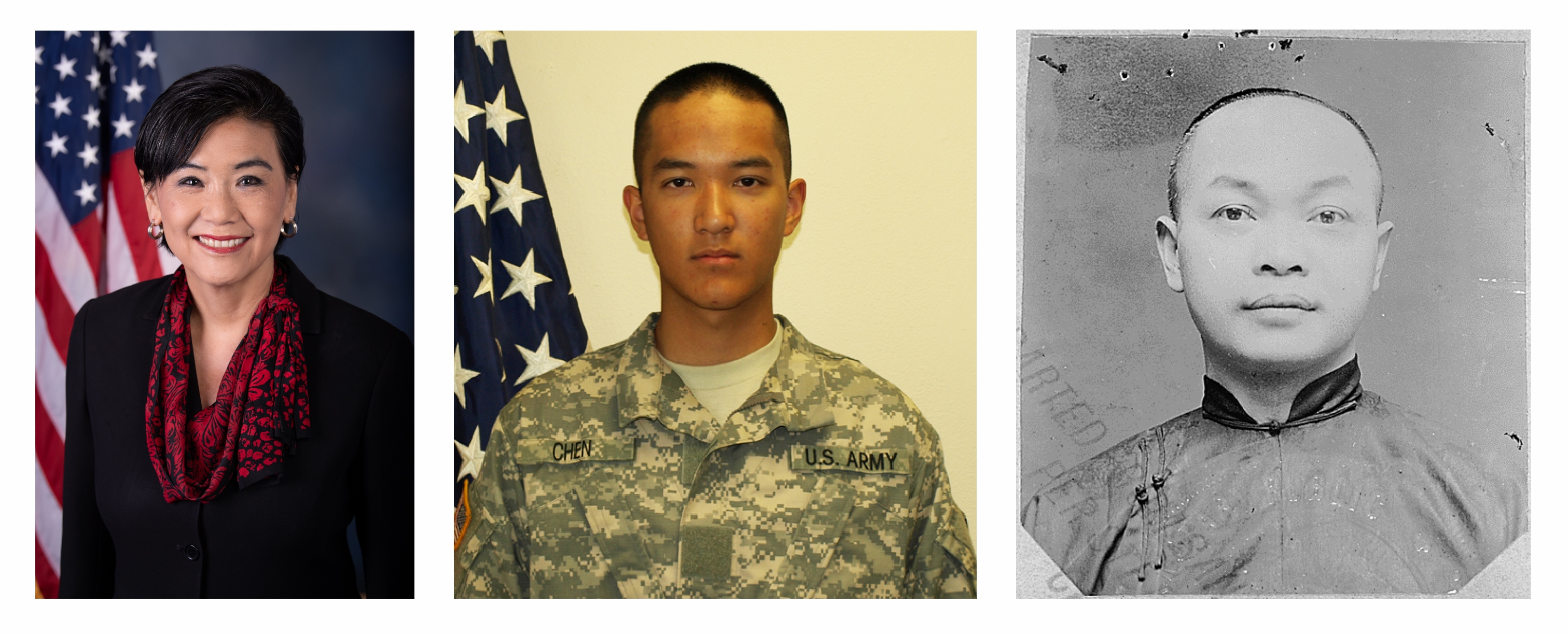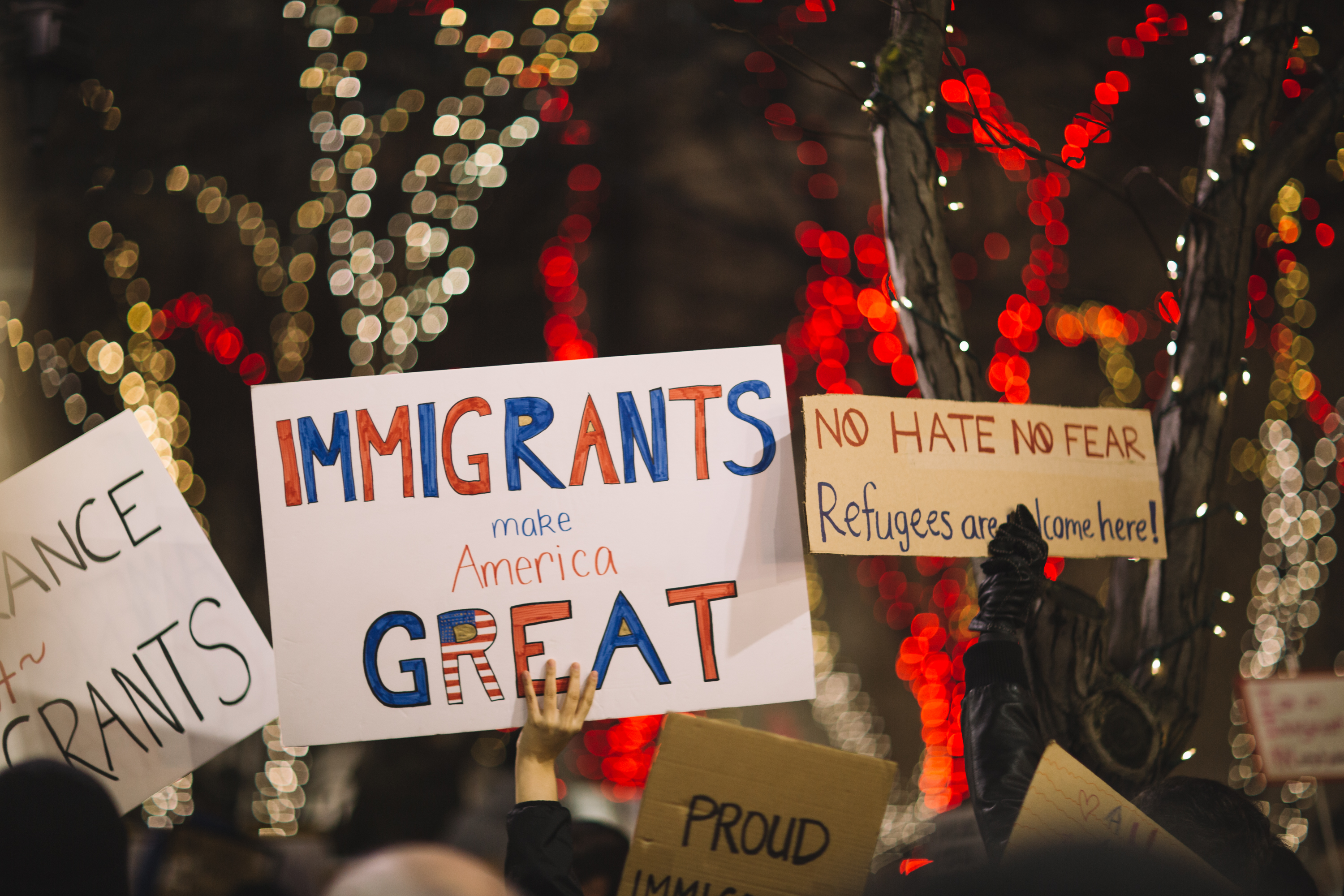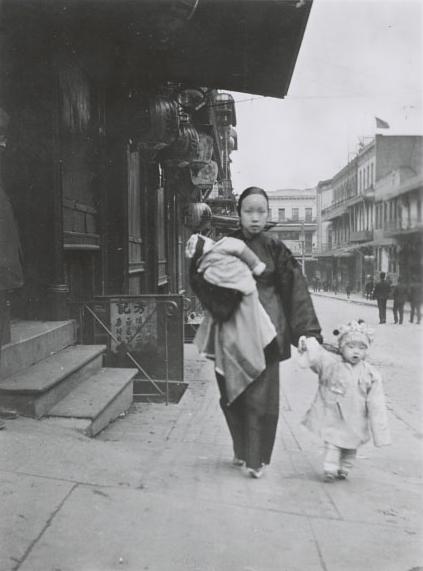6.6.5 - Challenges to Success - Perpetual Foreigner
Lesson Plan to Support Committee of 100's From Foundations to Frontiers:
Chinese American Contributions to the Fabric of America Report
The Asian American Education Project
All content is owned by The Asian American Education Project (AAEdu).
As such, users agree to attribute all work to The Asian American Education Project.
This photograph was taken at a rally in Chinatown in Washington, DC in March 2021. During the COVID-19 pandemic, there was a rise in anti-Asian and anti-Chinese violence that was often rooted in the Perpetual Foreigner Stereotype.
Credit:Elvert Barnes,
CC BY-SA 2.0, via
Wikimedia CommonsSource
Grade: 6-9Subject:
History, Social Science, English Language Arts
Number of Lessons/Activities: 4 + Extension Activities
This lesson plan supports the Committee of 100’s report entitled, "
From Foundations to Frontiers: Chinese American Contributions to the Fabric of America.” It addresses the sections entitled, “Building an Economic Powerhouse” (p. 26), “Strengthening American Institutions” (p. 38), and “Threading the Social Fabric” (p. 49). More specifically, it focuses on how the Perpetual Foreigner Stereotype has been and is used against Chinese Americans to inhibit their success and achievement in the United States, across various fields and sectors of society.
In this lesson, students will learn how the Perpetual Foreigner Stereotype has impacted Chinese Americans in the fields of science and technology, civic engagement, and the arts. Students will identify the specific ways that this stereotype has manifested, from racial profiling to exclusion and more. Students will analyze how this specific form of racism and xenophobia creates barriers and challenges for Chinese Americans.
Students will:
- Define the Perpetual Foreigner Stereotype
- Describe how the Perpetual Foreigner Stereotype impacts Chinese Americans
- Analyze how the Perpetual Foreigner Stereotype creates barriers to success for Chinese Americans
Challenges to Success - Perpetual Foreigner Essay:
Those with Asian and/or Pacific Islander heritages are affected by the
Perpetual Foreigner Stereotype. This stereotype suggests that people who look “Asian” are outsiders or foreigners. It doesn’t matter if they were born in the United States. It doesn’t matter if they live in the United States. It doesn’t matter if their families have been here for generations. It positions Asian Americans and Pacific Islanders (AAPI) as always being different. They are not seen as “Americans.” This stereotype has affected many different
fields.
The stereotype has been used against the AAPI community. This has happened since they arrived in the United States. It started when the Chinese
migrated in large numbers in the 1850s. Chinese immigrants were seen as different. They wore “strange” clothes. They spoke a “strange” language. They had “strange” customs. Laws were passed to ban them from immigrating. Laws also denied them equal opportunities. Laws have also led to their incarceration. In addition, Chinese and other Asian immigrants were often victims of anti-Asian attacks. This was all allowed because they were seen as foreigners.
The Perpetual Foreigner Stereotype is also evident In the area of science and technology. For example, Chinese scientists have been
racially profiled. Since the 1950s, scientists of Chinese
descent in the United States have been accused of being Chinese spies. Some even faced criminal charges. Some cases were valid. But many of the charges were dismissed.
Even the White House has suspected the Chinese government of spying. They accused them of using students to collect
intellectual property. This led to the suspension or limitation of visas. The United States was especially suspicious of students involved in China’s
civil-military fusion program. These students were denied visas to study in the United States. There are also
legislative proposals to restrict all Chinese graduate students from studying STEM-related subjects. Such decisions are fueled by the Perpetual Foreigner Stereotype. This negatively impacts Chinese Americans' access to opportunities. By cutting off talent sources, It also negatively impacts the country’s ability to innovate.
This distrust of Chinese American scientists is a problem. It has kept the United States from tapping into their talents. It has kept Chinese students from coming to the United States to study. The Perpetual Foreigner Stereotype must actively be overcome. More and more Chinese Americans are breaking through. In recent years, there has been an increase in foreign students in the United States from China. Many of these students are majoring in
STEM. STEM stands for Science, Technology, Engineering, or Math. These areas are critical to U.S. national security and interests. Chinese immigrants and Chinese Americans have greatly contributed to U.S. innovations in science and technology.
The Perpetual Foreigner Stereotype also affects the area of voting. Initially, many Chinese and other AAPI immigrants were denied the right to vote. However, laws have changed. The number of
eligible Chinese Americans voters grew by 57% between 2008 and 2018. Yet, voter
turnout rates for Chinese American voters remain low. One major reason for this is that Chinese Americans are not seen as “Americans.” Their issues and concerns are often ignored. Candidates of the Democratic and Republican parties have historically failed to reach out to AAPI communities. As members of U.S. society, AAPI communities should be actively included in shaping the nation’s future. Their votes should count. As such, broader efforts are needed to engage Chinese American voters with U.S. politics.
In the arts, the Perpetual Foreigner Stereotype has hurt AAPI
creatives . Artists of AAPI descent are expected to make “Asian” art. Such art is rarely seen as “American.” At best, it has been seen as a bridge between “Eastern” and “Western” art. This is very limiting. It is also dismissive. Increasing the visibility of Chinese and other minorities in American arts culture could open up new innovations in this field.
Barriers like stereotypes prevent individuals and communities from achieving their full potential. Removing such barriers will allow U.S. society to grow, thrive, and innovate.
*This text is an excerpt from the Committee of 100’s report entitled, “From Foundations to Frontiers: Chinese American Contributions to the Fabric of America.” It has been adapted for reading accessibility and clarity.
- Civil-Military Fusion Program: China’s national strategy to build China’s economic and technological achievements into military power
- Creatives: people who pursue careers in creative fields such as the visual and performing arts
- Descent: the origin or background of a person in terms of family or nationality; heritage and/or ancestry
- Eligible: being qualified or permitted to do or be something
- Incarceration: the act of imprisoning someone or the state of being imprisoned
- Intellectual Property: any intellectual creation, concepts, ideas, inventions, or work that are protected by law as belonging to the creator
- Fields: disciplines or areas of study
- Foreign: outside a place or country; not belonging to this country
- Legislative: relating to the branch of government that is charged with such powers as making laws, levying and collecting taxes, and making financial appropriations
- Migrate: move from one area to another
- Perpetual: never-ending or forever
- Racial Profiling: the act of suspecting or targeting a person on the basis of their race
- STEM: a word that means Science, Technology, Engineering, and Math
- Stereotype: an idea that many people have about a thing or a group that may often be untrue or only partly true and is often negative
- Turnout Rates: participation rates of a given election
- Visas: endorsement on a passport by the proper authorities showing that it’s been examined and the bearer may proceed
- What is the Perpetual Foreigner Stereotype?
- How has the Perpetual Foreigner Stereotype been used against Chinese Americans and other AAPI groups? How has this stereotype showed up in various fields/professions?
- In what ways is the Perpetual Foreigner Stereotype a barrier and challenge for Chinese Americans and other AAPI groups?
- What are some of the broader impacts of stereotyping?
This photograph shows a mother walking with two children in San Francisco Chinatown before 1910 (date unknown). When Chinese immigrants began to arrive and settle in the late 1800s, they were seen as different, strange, and foreign.
Credit:California Historical Society, Public domain, via
Wikimedia Commons California Historical Society
Activity 1: Introducing the Perpetual Foreigner Stereotype (Suggested Time: 20 minutes)
- Have students do a Quickwrite on what they know about stereotypes. If needed, use the following guiding questions:
- What is a stereotype?
- Have you been stereotyped? Have people unfairly judged you? How did that make you feel?
- Why do people stereotype?
- Facilitate a discussion by asking the following questions:
- Why do people stereotype?
- Where do stereotypes come from? How do we learn stereotypes?
- Tell students: “We are all susceptible to believing and spreading stereotypes because of the way that they are part of narratives we see in the media, the different systems that impact our lives (i.e., criminal/legal system, immigration, education, healthcare, etc.), how people relate to one another, and more. Stereotypes are everywhere.”
- Have students draw a picture of what an “American” looks like. Have students work in small groups and discuss the similarities and differences between their images.
- Have students watch this video entitled, “I am an American.” Facilitate a discussion by asking the following questions:
- What did the video show?
- What is the message behind the video?
- Why are Asian Americans and Pacific Islanders not always perceived to be Americans? Why is this problematic?
- Write the following definition for stereotype and display for all to see: “A stereotype is an idea that many people have about a thing or a group that may often be untrue or only partly true and is often negative.” Allow students the opportunity to revise and/or shape this definition.
- Tell students: “We all have a shared responsibility to reflect and consider which stereotypes we might hold and their impacts on other people and groups. This lesson covers a specific stereotype - the Perpetual Foreigner Stereotype - and how it impacts Chinese Americans. Although the lesson focuses on Chinese Americans, the Perpetual Foreigner Stereotype also impacts other Asian American and Pacific Islander (AAPI) communities, as well as other communities of color, like Latinx Americans, Arab Americans, etc.”

This cartoon entitled, “What Shall We Do with Our Boys,” was published in
The Wasp, a San Francisco-based magazine, on March 3, 1882. Images like this were commonly seen in mass media publications to spread anti-Chinese sentiment and create stereotypes of Chinese people. Chinese immigrants were portrayed as foreign and a threat to white workers’ jobs.
Credit: George Frederick Keller, Public domain, via
Wikimedia Commons Source
Activity 2: Understanding the Perpetual Foreigner Stereotype (Suggested time: 60 minutes)
- Have students read the essay. Consider the following options:
- OPTION 1: Have students read the essay independently either for homework or during class time.
- OPTION 2: Read aloud the essay and model annotating.
- OPTION 3: Have students read aloud in pairs or small groups.
- Facilitate a class discussion by asking the following questions:
- What is the Perpetual Foreigner Stereotype?
- How has the Perpetual Foreigner Stereotype been used against Chinese Americans and other AAPI groups? How has this stereotype showed up in various fields/professions?
- In what ways is the Perpetual Foreigner Stereotype a barrier and challenge for Chinese Americans and other AAPI groups?
- What are some of the broader impacts of stereotyping?
- Have students identify prominent Asian Americans. Write student responses down and display for all to see. Have students watch this news video entitled, “More Americans See Asian Americans as ‘Perpetual Foreigners.’” Have students review their list of prominent Asian Americans. Facilitate a discussion by asking the following questions:
- What more did you learn from this video?
- Why don’t people know more prominent Asian Americans? Why is this problematic?
- What are the causes of the Perpetual Foreigner Stereotype?
- What are the effects of the Perpetual Foreigner Stereotype?
- Distribute the worksheet entitled, “Perpetual Foreigner - Extended Definition.” Have students complete the worksheet in order to build on their conceptualization of the Perpetual Foreigner Stereotype. Encourage students to use what they learned from the text and videos.

In Activity 3, students have the option to research Chinese Americans and how they were affected by the Perpetual Foreigner Stereotype. Students may research U.S. Representative Judy Chu (left), U.S. Army soldier Danny Chen (center), or Wong Kim Ark (right) who fought for citizenship in the case
United States v. Wong Kim Ark (1898), among others.
Left - Credit: Eric Connolly, House Creative Services, Public domain, via
Wikimedia Commons,
SourceCenter - Credit: JOINT BASE ELMENDORF-RICHARDSON, Alaska, Public domain, via
Wikimedia Commons,
SourceRight - Credit: National Archives and Records Administration, Public domain, via
Wikimedia Commons,
Source
Activity 3: The Impacts of the Perpetual Foreigner Stereotype (Suggested time per Option: 60 minutes)
Teachers can have students complete one or more of the following options:
- OPTION 1: Have students read one or both of these articles: “How Did The US's History of Anti-Asian Racism Start? It Goes Back Centuries” and/or “The long history of racism against Asian Americans in the U.S.” Individually or in small groups, have students select an event mentioned in the articles to research and then complete the worksheet entitled, “Event Analysis.” Have students present their findings to the class. Facilitate a discussion by asking: “What is the impact of the Perpetual Foreigner Stereotype on the Chinese/Asian American community?”
- OPTION 2: Divide students into small groups and assign each group to study one of the following Chinese Americans:
- Anna May Wong (actress)
- Eugene Moy (newspaper editor)
- Xiaoxing Xi (physicist and university professor)
- Judy Chu (U.S. Representative from California)
- Wong Kim Ark (laborer)
- Vincent Chin (auto worker) *
- Danny Chen (U.S. Army soldier) *
- Have students create a visual timeline of the person’s life including how they were affected by the Perpetual Foreigner Stereotype and how they overcame it.
- Have students present their findings to the class. Facilitate a discussion by asking: “What is the impact of the Perpetual Foreigner Stereotype on the Chinese/Asian American community?”
*These individuals’ experiences include violence and death as a result of the Perpetual Foreigner Stereotype.

This photograph was taken at a rally in Seattle in January 2017. In Activity 4, students will create a poster or ad campaign educating the general public about the Perpetual Foreigner Stereotype.
Credit: Nitish Meena Nitishm, CC0, via
Wikimedia CommonsSource
Activity 4: Educating the Public on the Perpetual Foreigner Stereotype (Suggested time: 60 minutes)
- Have students create a poster or ad campaign educating the general public about the Perpetual Foreigner Stereotype and encouraging the general public not to perpetuate it. Have students include a definition, causes, barriers, impacts on Chinese Americans, impacts on American society more broadly, and specific examples. Have students use visuals, videos, taglines, and more.
Extension Activities (Suggested time per Option: 30- 60 minutes)
- Have students make a one-page infographic that describes and refutes the Perpetual Foreigner Stereotype. Have them define the stereotype and provide at least two data points or concrete examples that counter the stereotype.
- Divide the class into five groups and have each group watch a different segment of the
PBS "be/longing: Asian Americans Now" series. Have each group write a short response to the video, covering the individual being profiled in their video and how the Perpetual Foreigner Stereotype has impacted or relates to them. Have each group present their findings.
- Have students read
“Combatting the AAPI Perpetual Foreigner Stereotype” and write a short argumentative essay on how the Perpetual Foreigner Stereotype is false and misleading, using data and findings from the article.
- Have students think of a time when they felt like an outsider and have them journal about their feelings. Have them think of a time when they were an insider and have them journal about their feelings. Have them analyze what it means to an outsider versus an insider and which position they liked better and why.
- Have students read the two essays in The Asian American Education Project lessons entitled, “Perpetual Foreigner” and “Model Minority Myth.” Then, have students create and complete a Venn Diagram comparing and contrasting the two stereotypes. Have students write a brief explanation of how the stereotypes impact Chinese Americans.
- Have students read the article entitled, “Asian Americans and the ‘forever foreigner’ stereotype.” Have students write an explanation of the significance of both quantitative and qualitative data in understanding the stereotype.
Additional Fictional Resources
- American as Paneer Pie by Supriya Kelkar (Simon & Schuster Books for Young Readers, 2021) - Have students discuss how the Perpetual Foreigner Stereotype impacts the Indian American community in this book. Have students discuss how Lekha and Avantika’s thoughts and actions are influenced by their own beliefs about the Perpetual Foreigner Stereotype. Have students reflect on the title of the book and make a connection to the readings or videos in this lesson.
- American Born Chinese by Gene Luen Yang (First Second, 2008) - Have students discuss how the Perpetual Foreigner Stereotype is portrayed in the book and what the author’s purpose is with the character Chin-Kee. Have students watch the television adaptation on Disney+ and create a Venn diagram to compare and contrast how the book and television series depict the Perpetual Foreign Stereotype.
- Finally Seen by Kelly Yang (Simon & Schuster Books for Young Readers, 2023) - Have students compare and contrast the experiences of Lina and Millie. Have students evaluate the extent to which their struggles are rooted in the Perpetual Foreigner Stereotype.
- In the Beautiful Country by Jane Kuo (Quill Tree Books, 2023) - Have students discuss how the Perpetual Foreigner Stereotype impacts Anna and her family when they immigrate to the United States. Have students analyze specific examples of racism they face and discuss whether or not they are rooted in the Perpetual Foreigner Stereotype.






